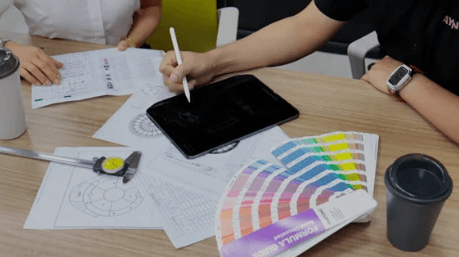Injection molding is a widely used manufacturing process for producing plastic parts by injecting molten material into a mold. Designing parts for injection molding requires careful consideration of various factors to ensure manufacturability, cost-effectiveness, and part quality. Here’s an overview of essential design principles:
1. Wall Thickness
Uniformity:Maintain consistent wall thickness to prevent issues like warping and sink marks
Guidelines:
-Standard thermoplastics: 1.5–3 mm
-Thicker sections may require reinforcement or ribbing.
2. Draft Angles
Purpose acilitate easy ejection of the part from the mol.
Recommendation Apply a draft angle of at least 1° per side, increasing with part dept.
3. Radiiand Fillets
Benefits: Reduce stress concentrations and improve material flw.
Design Tip: Use radii at corners; a minimum inside radius of 0.5 times the wall thickness is advisabe.
4. Undercuts
Challenge: Undercuts complicate mold design and increase cots.
Solution: Design parts without undercuts or use side actions if necessry.
5. Gate Design
Types:
Edge Gat: Common for rectangular prts.
Pin Gat: Suitable for cylindrical prts.
Submarine Gat: Ideal for automatic de-gaing.
Consideration: Gate location affects part filling and appearnce.
6. Ribbing and Coring
Purpoe: Enhance part strength without increasing wall thicness.
Guidelines:
Ris: Should be 40–60% of the adjacent wall thicness.
Corig: Reduces material usage and wight.
7. Hole Design
Best Practices:
Through Hoes: Preferred over blind holes for ease of mlding.
Depth-to-Diameter Raio: Keep it under 2:1 to prevent issues during mlding.
Spacng: Maintain at least the hole diameter between holes or between a hole and the par edge.
8. Surface Finish and Texturing
Considerations:
Texture Dpth: Affects draft angle requiements.
Finish ype: Affects part aesthetics and functinality.
9. Mold Design Considerations
Mold Components:
Core and Cvity: Form the parts shape.
Cooling Chanels: Ensure uniform cooling to preventwarping.
Ejection Sstem: Facilitate part removal withou damage.
10. Simulation and Analysis
Tools: Software like Autodesk Moldflow or SolidWorks Plastics can simulate material flow, cooling, and potentia defects.
Beefits: Identifies issues early, reducing prototyping costsand time.
DAYIN Plastic Products Co., Ltd. is a high-quality injection mold design company and OEM injection mold manufacturer that focuses on home appliance mold manufacturing and provides OEM/ODM services. Founded in 1989, the company is a manufacturing solution provider that integrates Research and injection mold Development and manufacturing services.
If you have specific questions or need further details on any aspect, feel free to ask!

